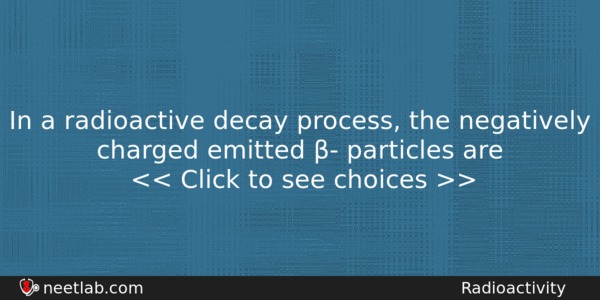| ⇦ | 
| ⇨ |
In a radioactive decay process, the negatively charged emitted β- particles are
Options
(a) the electrons produced as a result of the decay of neutrons inside the nucleus
(b) the electrons produced as a result of collisions between atoms
(c) the electrons orbiting around the nucleus
(d) the electrons present inside the nucleus
Correct Answer:
the electrons produced as a result of the decay of neutrons inside the nucleus
Explanation:
In beta minus decay (β⁻), a neutron is transformed into a proton, and an electronis emitted from the nucleus along with antineutrino.
n = p + e⁻ + v⁻
Related Questions: - A bar magnet has a coercivity of 4×10³ Am⁻¹. It is placed inside a solenoid
- In the spectrum of hydrogen, the ratio of the longest wavelength in the Lyman series
- A particle has initial velocity(3i⃗ +4j⃗)and has acceleration (0.4i⃗ +0.3j⃗)
- Ist law of thermadynamics is based on
- Two thin lenses when placed in contact, then the power of combination is +10 D.
Topics: Radioactivity
(83)
Subject: Physics
(2479)
Important MCQs Based on Medical Entrance Examinations To Improve Your NEET Score
- A bar magnet has a coercivity of 4×10³ Am⁻¹. It is placed inside a solenoid
- In the spectrum of hydrogen, the ratio of the longest wavelength in the Lyman series
- A particle has initial velocity(3i⃗ +4j⃗)and has acceleration (0.4i⃗ +0.3j⃗)
- Ist law of thermadynamics is based on
- Two thin lenses when placed in contact, then the power of combination is +10 D.
Topics: Radioactivity (83)
Subject: Physics (2479)
Important MCQs Based on Medical Entrance Examinations To Improve Your NEET Score
18000+ students are using NEETLab to improve their score. What about you?
Solve Previous Year MCQs, Mock Tests, Topicwise Practice Tests, Identify Weak Topics, Formula Flash cards and much more is available in NEETLab Android App to improve your NEET score.
Share this page with your friends

Leave a Reply